- Health Is Wealth
- Posts
- Polar Vantage V: the multisports and triathlon watch for professionals
Polar Vantage V: the multisports and triathlon watch for professionals
Features of the Polar Vantage V
Detailed review of the Polar Vantage V, the watch for demanding athletes and pros
Differences between Vantage M and Vantage V
Our opinion: should you buy the Polar Vantage V?
Price and availability
Buy the Polar Vantage V
Trader
Price (from)
Pope
499 € 419
i-Run
€ 499 -5% (* 1)
Alltricks
499 € 429.99
Amazon
499 € 370.44
Go-Sport
€ 473
(* 1) Discount of -5% on polarVantageV with the promo code FORM !
Commercial links. Non contractual prices. Please consult the merchant website.
Replacing the Polar V800, the Vantage V is a premium multisport watch that offers functions aimed at helping athletes to maximize their performance. It has 130 sports profiles and is particularly well suited to the practice of triathlon. Its optical heart rate sensor, at the cutting edge of technology, has 9 LEDs and 4 sensors for more reliable measurements (the interface even corrects inconsistencies during data processing) and operation in water. It is the first watch to offer an instantaneous power measurement without an external sensor. The sports aid functions offered by this model are exceptional. In particular, it offers 2 new functions, Training Load Pro and Recovery Pro , powerful tools which allow athletes to analyze the effects of a sporting outing on different parts of the body and to optimally measure their workouts.
Discover our detailed review and our opinion on this astonishing watch but some of whose functions should be improved.
Features of the Polar Vantage V
Weight66g
Music playerNo
(embed) https://www.youtube.com/watch?v=w0w5T2_Gb64 (/ embed)
Detailed review of the Polar Vantage V, the watch for demanding athletes and pros
Who is the Polar Vantage V for?
The Vantage V is a multisport and triathlon watch that also monitors activity 24 hours a day. It is aimed at demanding athletes who are looking for advanced functions to analyze their performance and training assistance tools. High-level sportsmen, professionals, amateurs looking to train like the pros or even fans of statistics and analyzes will find their happiness there.
This new model replaces the Polar V800 by bringing new functions and especially interesting innovations that we describe below.
Note that some functions of the V800 have not been maintained on the Vantage V or will only be offered later by updates to the watch software. We talk about it later in this article.
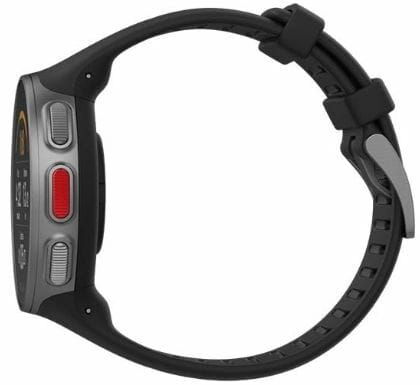
Design
The Vantage V is a watch with a sober design, in a stainless steel case and, new from Polar, whose screen is round. This may displease some, but for others, it is rather good news. Square screens can indeed cause discomfort during wrist movements.
Polar offers for this model a color touch screen of 240 x 240 pixels, like the Fenix 5, a nice improvement compared to the V800 (128 x 128 pixels). The touch screen can be used in watch mode (it is disabled during training). Note that the buttons must be used in addition to the touchscreen.
The Vantage V is a comfortable watch to wear despite its weight of 66 g (slightly higher than ultra-light watches but still 20 g lighter than a Fenix 5 Plus or a Suunto 9). Its strap is not interchangeable (unlike the Vantage M), which is a bit of a shame, especially for a watch designed to be worn everyday for activity monitoring.
An innovative cardio optic that works for interval training and underwater
Recall that Polar (short for Polar Electro Oy) is the inventor of the first wireless heart rate monitoring. After a first monitoring to take the pulse from a finger, Polar released its first cardio watch model in 1982! In 1995, the Finnish company went further by measuring the variability of the heart rate, a data which allows, among other things, to estimate the level of fitness. Polar has long been the benchmark for heart rate watches and the use of the pulse for athletes.
The introduction of optical heart rate sensors on the wrist is a great innovation and Polar was not outdone by releasing its first model equipped with such a sensor in 2015. With the Polar Vantage, the manufacturer marks a new step in offering an innovative optical monitoring full of sensors for more reliability and possible operation in unfavorable conditions, especially underwater.
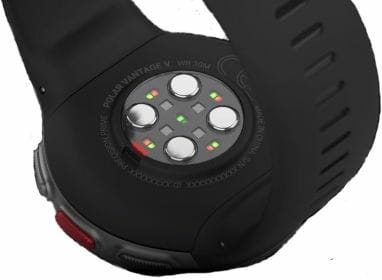
The Vantage V's optical sensor is made up of 9 LEDs of different wavelengths (red and green colors) and 4 light sensors, all aimed at making the measurements more reliable. In addition to this, 4 electrodes have been added to ensure good contact of the sensors with the skin. Outdoor light is the biggest parasitic source of optical heart rate monitors.
In addition to these improvements, Polar fixes the recordings to eliminate inconsistencies. For example, if a measurement indicates 160 bpm while the 2 measurements surrounding it indicate a frequency of 140 bpm, the measurement at 160 bpm will be considered as spurious and eliminated.
Thanks to these improvements, the Vantage's cardio optics work in water, which is a first. Triathletes and swimmers will therefore be able to benefit from more comprehensive measures (calories burned, etc.) without having to wear a chest belt. The measurements can also be used in interval training, where most of the other cardio optical watches fail to provide consistent measurements due to too rapid pulse variations. Cyclists will also appreciate, the optical cardio is generally poorly suited to cycling.
Overall, tests carried out on the Vantage V show good reliability and consistency in measurements, whether for swimming, running or cycling, but user opinions differ (read our opinion below). That said, the chest strap is still the best option for reliable measurements. Polar also offers an optional H10 belt with the watch, which is also essential for carrying out the orthostatic tests offered by the Vantage.
Power measurement without an external sensor: for more targeted training
Also great news on this model, a power sensor on the wrist evaluates the instantaneous power developed during running. The particularity here is that it does not require any external sensor (Stryd, footpod, etc.).
Why use power rather than heart rate to train? Heart rate has long been used as an indicator of the level of exertion. Hence its use to target training. In reality, the power is a more interesting indicator than the measurement of the pulse because it perfectly reflects the effort produced by the sportsman while the heart rate is influenced by other parameters (level of heating, level of training , stress, diet, fatigue, etc.). In addition, the heart rate does not react instantly to variations in rhythm or load. In the case of an acceleration for example, the heart takes a certain time to increase in frequency and the maximum reached depends on the prior heating. The instantaneous power, as for it, is a function of the intensity of the effort (power = force x speed). It is therefore much more suitable for training.
Estimating the developed power is however not a small matter since it would be necessary to be able to note the force exerted by the runner but also to take account of the conditions of race: type of ground (running in sand is not the same thing than running on tarmac!), weather conditions (rain, wind, etc.), slope, etc.
To estimate power without using a sensor, Polar uses the energy expended by the runner for a short period of time. Kinetic energy (proportional to the mass of the runner and his speed, i.e. 1/2 mv2) and the potential energy (proportional to the mass of the runner and the difference in height, ie mh) are thus taken into account. The power developed is all the higher as the athlete weighs heavy, runs fast and climbs high.
The measurements are made using GPS (speed, distance traveled), the accelerometer (accelerations, decelerations) and the barometric altimeter (measurement of altitude difference traveled).
The athlete can thus train from a power target (rather than target heart rate zones), for example for the interval training. Polar also uses power in its Training Load Pro function, to assess the load that training exerts on the muscular system.
(embed) https://www.youtube.com/watch?v=0ndpqbDFUM8 (/ embed)
Advanced training functions. New Training Load Pro and Recovery Pro functions
In addition to the Polar features offered on the V800, such as the Running Index (VO2max assessment), training efficiency (impact of a session on training), the orthostatic Review (recovery evaluation), Running Programs (personalized training programs to prepare for a race: 5 km, 10 km, half-marathon or marathon), Polar offers two new functions on its Vantage V: Training Load Pro and Recovery Pro.
These highly sophisticated features track your training load and recovery in the short and long term and help you tailor your training accordingly. The idea is to optimize your work and reduce the risk of injury and overtraining. The watch takes into account your physical stress but also the stress of daily life to advise you the best possible
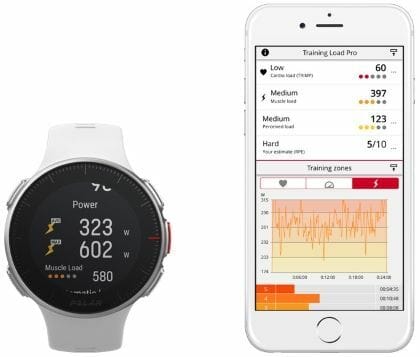
Training Load Pro allows to quantify the load of a training session on the cardiovascular system and on the muscles. This tool also takes into account the athlete's feelings. It measures the cardiac load (that undergone by the body. The measurement is made thanks to the heart rate monitoring), the muscular load (that felt by the muscles. It is evaluated by the measurement of the developed power) and the feeling of the sportsman ( to enter in the interface). This function allows you to assess the impact of training on your body (the watch gives a numerical score, a verbal report and a visual scale for each training load) and to adjust the sessions accordingly.
Recovery Pro lets you know how your body is recovering from stress and advises you to avoid overtraining or injury. The recovery measurement is carried out by an orthostatic Review of a few minutes at rest to be done 3 times a week (requires the Polar H10 belt). The watch provides recommendations for the activity you can undertake.
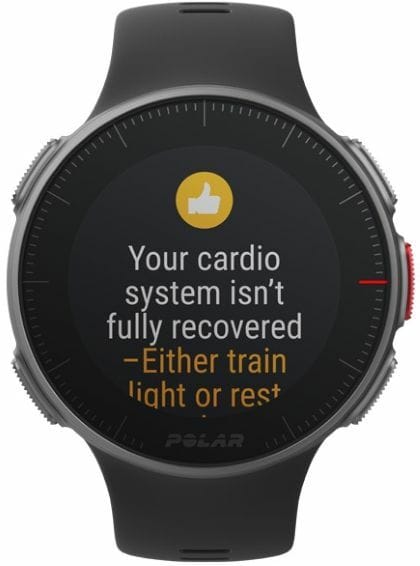
The sensors
The Vantage V has a GPS, a barometric altimeter, an accelerometer, an optical cardio on the wrist. It is compatible with many external sensors operating in Bluetooth, in particular: cadence, power, speed (cycling), cadence, stride (running), cardio belt.
The activity tracking function (tracker)
The Vantage V has an activity tracker for 24-hour monitoring of your activity: number of steps, distance traveled, calories expended, sleep analysis. For the latter, the Polar Sleep function is based on wrist movements to calculate the duration and quality of sleep. The optical sensor is not used (unlike other cardio watches or activity bracelets which use it to analyze sleep phases in more depth). The watch issues inactivity alerts and informs its user about the efficiency of its activity.
smart health connected functions: very limited at the moment
Most current cardio watches offer smart health connected functions that allow at least to be notified of calls, emails and SMS (Smart notifications) or even to control the music on your Smartphone, access the calendar, respond with predefined messages, control a VIRB camera and more. But for this new Polar model, no Smart notifications yet! These functions should however be added in the first quarter of 2019.
In the meantime, the watch allows you to connect to the Polar ecosystem for the transfer of data from the watch or to the watch (polar Flow interface) or even for synchronization with third-party services such as TrainingPeaks, Strava, Apple Health Kit, Google Fit, MyFitnessPal.
Autonomy: impressive!
Polar announces the impressive 40 hours of autonomy for its Vantage V (30 hours for the Vantage M) for use with GPS and recording every second! In comparison, the Garmin Fenix 5 only reaches 6 p.m. (32 h for the Fenix 5X Plus) and the Suunto 9 Baro 25 h.
The Vantage does not offer energy saving mode, which is unfortunate for all those who make very long trips, especially since the watch cannot be recharged in recording mode. For record autonomy without altering the accuracy of the measurements too much, the Suunto 9 remains (in 2018) the benchmark.
Differences between Vantage M and Vantage V
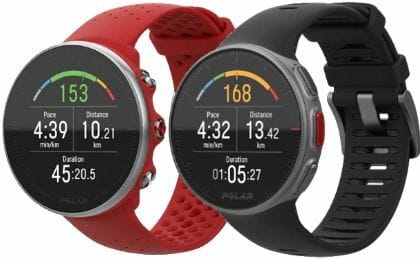
Polar has released the Polar Vantage M and the Polar Vantage V, two sports watches aimed at a different audience. The two do not have the same goal at all.
The Vantage V is a Premium watch aimed at athletes looking for performance and optimizing their training. It is suitable for the practice of triathlon. It offers advanced functions which do not necessarily belong to amateur or occasional athletes.
The Vantage M is a complete multisport watch, more geared towards running. It is aimed at athletes who like statistics and the analysis of their outing to progress, avoid overtraining, improve their performance. It is equipped with the brand new optical cardio from Polar (like the Vantage V) but it is lightened in terms of hardware and functionalities. Among the differences, we note:
No touch screen
A little weaker but still excellent autonomy (30 hrs instead of 40 hrs)
Lighter (45 g instead of 66 g)
No barometric altimeter
No instantaneous power measurement
No Recovery Pro function (but it offers Training Load Pro function)
No interchangeable strap (unlike the Vantage V)
Our opinion: should you buy the Polar Vantage V?
At first glance, the Polar Vantage V seems very attractive for its revolutionary optical cardio and its innovative wrist power sensor. Its training analysis functions are very advanced and comprehensive. Polar also has a great reputation for the quality of its heart rate measurements and its operation. The firm has been a pioneer in this field and continues to convince the market for the reliability of its data. The Vantage V caught our attention for this. We also appreciated the sober design of the watch, its comfortable wearing on the wrist (you don't feel it) and its impressive autonomy.
Now, a number of points remain disappointing not only on paper (specifications) but also in practice. If several tests published on the Internet show good results, user opinions are nevertheless mixed regarding the quality of GPS and cardio optical data on the wrist. In addition, some functions present on the V800 and yet very useful have disappeared on the Vantage V! Polar will bring updates in the coming months but some functions will no longer be supported, too bad. The point below.
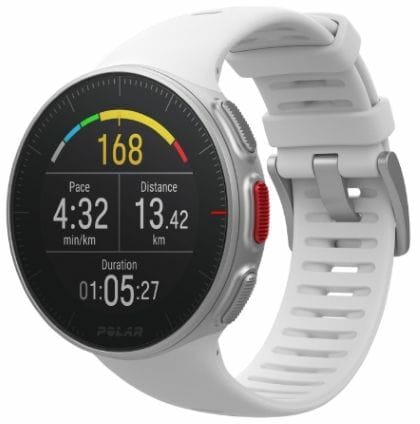
Design and features: quite satisfactory
We liked the new design proposed by Polar, the watch and its discreet and round shape not being felt during the movements of the wrist.
The touch screen is appreciable even if the fluidity of the display remains to be improved. Reading is comfortable apart from the somewhat small size of certain data (inconvenient to read when on the move) and a somewhat faint display in the sun. The lighting of the watch at night is also a bit dim. Too bad that Polar does not offer watchfaces.
Vibration alerts are not very powerful but this can be a positive point for some people.
Finally, we wonder why the strap is not interchangeable when it is on the Polar Vantage M! An inconsistency all the more surprising since the watch was designed to be worn in everyday life (sport and city).
The features: good tools, some disappointments but new things to come
The watch offers new innovative functions (power measurement without external sensor, Training Load Pro and Recovery Pro) which we think are very complete and will delight athletes looking for detailed analyzes of their training. These functions are a great help to athletes who want to optimize their training while taking care of their bodies.
In return, the amazing has lost a number of functions yet present on the Polar V800. Polar will offer some of these functions in future updates to the watch software, but others will not be implemented in principle, which is a shame.
Among the functions present on the V800 but removed from the Vantage, we find ZoneLock (training targets based on predefined values of HR, speed, pace or power), Jump Review (evaluation of muscle strength, power and fatigue of the leg muscles) and the energy saving mode. The latter has nevertheless become today one of the most important characteristics of ultratrail and ultra-deep runners! Especially since the Vantage cannot be recharged during an outing!
Among the functions which should be implemented soon, we find in particular the activity alerts, the import of routes, the Strava Live segments, the Polar Fitness Review, the guide or tracking of route (GPS track) and the function of return to the starting point, the timer for the fractional, the classic smart health connected functions (smart notifications, music control of the Smartphone, etc.). In short, essential functions today. Fortunately, Polar plans to introduce them in the coming months!
In addition, there is no mp3 player, no mapping, no payment system or other functions more or less useful on this model, but which attract new users. Polar prefers to focus on purely sporting functions. It must also be said that the manufacturer designs everything himself, which makes upgrading difficult in the face of competition. A Bluetooth wireless music player would however be appreciated by many runners who like to listen to music during their sport but who do not want to bother with a Smartphone.
<img src = "https://action.metaffiliation.com/trk.php?maff=P2B043DCA23127″ alt=”Fitnessboutique "border =" 0″>
The quality of the cardio optical measurements: it all depends on the conditions
If cardio optics is a beautiful innovation that seems promising on paper, the opinions of the first users of the Vantage seem less convincing. Despite the increase in the number of LEDs, the 2 wavelengths to better reach the different layers of the epidermis and the electrodes to detect poor measurement conditions, the reports observed sometimes differ greatly from reality.
Remember that an optical heart rate monitoring on the wrist (detection of blood movement in the veins) can never match a chest belt (measurement of electrical impulses). The quality of the measurements depends on a certain number of parameters such as the skin type, the hairiness, the blood circulation at the level of the sensor, the correct position of the cardio on the wrist, the degree of humidity, the amount of perspiration. , wrist temperature, etc. Satisfactory measurements for one user may not be for another. This is why Polar requires the use of a belt for the orthostatic Review.
The Vantage's optical sensor nevertheless has the advantage of working in difficult conditions where most of the other watches fail: fractional, aquatic environment or even cycling for example. For reliable results, however, it is better to use a belt.
The GPS sensor: to review?
The quality of the Vantage's GPS measurements seem correct even if the measurements are not always in line with those of other competing watches. Some users even announce significant deviations. This remains to be confirmed because the accuracy of GPS chips today is 5 to 10 m, or even more depending on conditions (signal quality in particular). The size of the antenna plays an important role for this. With such a margin, it is therefore difficult to compare models with one another and to judge position differences of a few meters. It's like using a 1 degree precision thermometer to measure and compare 0.1 degree variations. Note that in town or in the forest, reception conditions are poor and it is the quality of the antenna that will make the difference between 2 watches, but also the satellite system (GLONASS, Galileo, etc.) and, don't forget, the software using the data. Galileo offers greater precision but the Polar does not use this system for its Vantage.
The goal of GPS watch manufacturers is also to have the most energy-efficient GPS chips possible and this does not necessarily require better accuracy, on the contrary. For the Vantage, Polar uses a Sony chip, less energy-hungry, of course, but less precise than the Sirf chip on board the Polar V800 (one of the most precise and accurate watches today even in terms of GPS measurements). We will still have to wait a bit until the next sports watches incorporate the brand new GPS chip offered by the Broadcom company. It would have an accuracy of only a few centimeters (about 30 cm depending on the signal) and would consume half the energy! An ideal candidate for a GPS watch!
Unlike its Polar V800, the degraded GPS mode (energy saving or Ultra mode) is no longer available! A limitation which will undoubtedly be prohibitive for followers of so-called "ultra" races. Polar does not seem to be sensitive to it, too bad …
Another point, which is not directly related to GPS, is the barometric altimeter. As the name suggests, it uses atmospheric pressure to estimate altitude. However, the Vantage does not allow the barometer to be calibrated. Polar should probably use GPS for this calibration but since the latter is not ultra precise in current watches, the calibration is far from perfect and can vary a lot with changes in atmospheric pressure!
Upcoming improvements on the Vantage V
Polar announces some upcoming improvements to its watch. Functions which seem essential to us and which should logically have already been delivered as soon as the model was released in October 2018. In addition, there will be fixes for the functions already delivered. We hope to find, among other things, improvements in the use of data from the optical heart rate monitoring and GPS.
For people who bought the Vantage before these updates, simply update the watch software via the Polar interface.
End of 2018: timer (for the split), improvements / fixes to functions already delivered
1er quarter 2019: Smart notifications, route import and route guide, return to starting point, navigation to waypoints for imported routes
During 2019: Strava Live Segments, Fitness Review, inactivity alerts
Conclusion
The Vantage V is aimed at a very sporty audience who loves data and analyzes and who is looking for concrete tools to better know themselves, optimize their performance and progress. We are a little disappointed by the vagaries of optical cardio and the accuracy of GPS lower, a priori, than the V800, which raises questions about the interest of this new model. Fortunately, the wrist pulse measurement, the Training load Pro and Recovery Pro functions, the measurement of the power and the activity monitoring bring to this watch a new breath which will interest a targeted public.
In view of the Vantage V tests and the assessments of the first buyers, this cardio watch does not seem completely ripe to us yet. Polar has likely targeted the holidays to optimize sales. A risky bet that may well discourage some fans of the brand, especially since many have been impatiently awaiting this new model, which has been awaited for years.
If you are looking for an all-purpose watch that offers advanced sports functions, cartography, a music player, the possibility of paying for your small purchases or various widgets, go your way. The Vantage was not designed for this. Turn instead to Garmin and its excellent Fenix 6 or, for the look and less sporty use, to an Apple Watch 5. For runners and triathletes, the Garmin Fenix 945 remains a reference.
For advanced sports use oriented running, trail or hiking and record autonomy ideal for so-called “ultra” courses, we currently recommend the Suunto 9 Baro as an interesting alternative to the Polar Vantage V.
We liked
Optical cardio possible for cycling, swimming and interval training
Excellent autonomy
Wrist power measurement without external sensor
Advanced sports support functions including Training Load Pro and Recovery Pro
We'd have liked
More navigation functions (route tracking, return to departure) (planned for 2019)
An mp3 player
Smart notifications (planned for 2019)
Watchfaces
An interchangeable strap
Price and availability
The Polar Vantage V has been available for sale since October 2018. It is available in 2 sizes and 3 colors (black, white and orange). You can buy it in specialized stores and on the Internet. Discover it with our partners and take advantage of our coupons.
Buy the Polar Vantage V
Trader
Price (from)
Pope
499 € 419
i-Run
€ 499 -5% (* 1)
Alltricks
499 € 429.99
Amazon
499 € 370.44
Go-Sport
€ 473
(* 1) Discount of -5% on polarVantageV with the promo code FORM !
Buy the Polar Vantage M
Trader
Price (from)
Pope
279 € 249
i-Run
€ 279 -5% (* 1)
Alltricks
279 249.99 €
Amazon
279 € 215
Go-Sport
279 € 264.58
(* 1) Discount of -5% on polarVantageM with the promo code FORM !
Commercial links. Non contractual prices. Please consult the merchant website.
Philippe Baudoin
Reproduction prohibited – Copyright © Sport Passion
These articles may also interest you
<! –
->
Casio Pro Trek WSD-F30: the smart health connected watch for adventurers
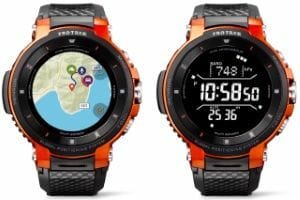
Casio Pro Trek WSD-F30: the smart health connected watch for adventurers
Read more
Fenix 5 Plus: the ideal sports watch?
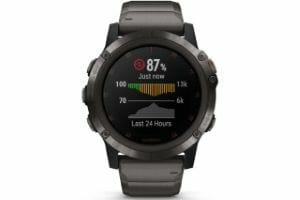
Fenix 5 Plus: the ideal sports watch?
Read more
Suunto 9 review: record autonomy and precision even without GPS!
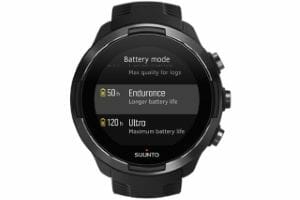
Suunto 9 review: record autonomy and precision even without GPS!
Read more
Best GPS 2020 watches for triathlon

Best GPS 2020 watches for triathlon
Read more
Best cardio GPS 2020 watches for running

Best cardio GPS 2020 watches for running
Read more
How to choose your cardio GPS watch?
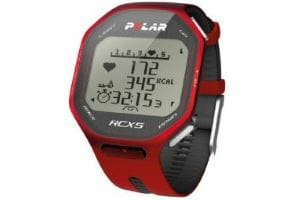
How to choose your cardio GPS watch?
Read more
Photo credit: Fotolia.com
AB SMART HEALTH REVIEW